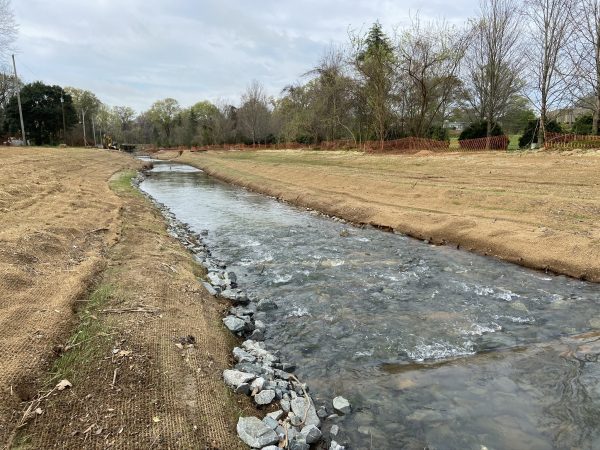Toby Creek: Restoration and an opportunity for learning

If you Googled “beautiful streams,” you’d find a plethora of cinematic, artistic shots of water gracefully flowing over the rocks. If you Googled “Toby Creek,” you may find something completely different.
Streams aren’t meant to just be beautiful for a quick social media picture. They play a key role in the environment. Toby Creek, located in the University area, is a valuable asset to UNC Charlotte and the surrounding community. However, it’s been long overdue for improvements.
In 2018, Mecklenburg County Storm Services set out to improve the stream and water quality to restore the creek to a stable and natural condition. Other goals include stabilizing eroded stream banks, restoring the floodplain to its natural state and function, improving habitat for aquatic life, streaming buffers with species diversity and additional plants and enhancing water quality.
Sounds like good things, right? Now that the stream is restored, what does all of this actually mean for the Charlotte community, specifically the University?
There are many reasons why. It’s about creating a healthier environment, but also nurturing a respect for nature and a learning opportunity for students on campus.
Greg Cole is a civil engineer acting as a representative for the University while collaborating with Mecklenburg County. With over 20 years of experience working on drinking water, sanitary sewer, stormwater, site design and other projects, Cole understands the importance of how healthy streams and greenways keep people linked with nature.
“Greenways and streams are crucial not just for healthy communities, but also for helping people remain connected to nature,” said Cole. “This is even more important in urban environments. As a premier urban university, we have a calling and responsibility to highlight how development can include a healthy environment.”
This is why it is so important to have the University involved in such an essential restoration project in Charlotte. By restoring Toby Creek, faculty members have a rare opportunity to educate students about Toby Creek’s importance and challenges in an urban environment through direct exposure.
Sandra Clinton is a river ecologist and faculty member at UNC Charlotte. Her research focuses on how urbanization impacts streams and evaluates how different strategies, such as restoration, stormwater control measures and green infrastructure, can mitigate these impacts.
“I use Toby Creek to teach principles and methods of stream ecology as part of my freshwater ecosystems class. Having access to a creek on campus enriches the learning experience for undergraduate and graduate students,” said Clinton. “The creek is also easy to access so all students in the class are able to participate in the outdoor labs.”
Sara Gagne, associate professor of landscape ecology, found a similar advantage. As well as being a professor, she led the proposal for the North Carolina Environmental Enhancement Grant program to monitor the impacts of the restoration on terrestrial and aquatic biodiversity along Toby Creek.
For teaching and learning purposes, Gagne proposed to have undergraduate and graduate students participate in the monitoring of Toby Creek and have signage added explaining the restoration’s importance. This is something Gagne actively practices with her students.
“This is an ideal location for students to see firsthand what an urban restored stream looks like, what natural channel design restoration projects look like and what several types of green stormwater infrastructure look like,” said Gagne. “We talk about the Urban Stream Syndrome and how and why restoration addresses USS symptoms. The Toby Creek restoration is an excellent real-world example of natural processes, their anthropogenic drivers and our responses to them.”
David Vinson, associate professor in the Department of Geography and Earth Sciences, works primarily in groundwater and groundwater-surface water interactions. This means rainfall on campus travels through streams or through the ground itself, which ultimately flows into Toby Creek.
Vinson uses Toby Creek to help students better understand the functions that cause water quality to form in streams in the Charlotte region. Instead of doing it in a lab, they can go to the actual stream, have a more intuitive experience and understand how streams affect water quality.
“This is a great teaching and learning opportunity for students to study a restored stream and understand Charlotte’s water quality,” said Vinson. “The hands-on experience from studying the conditions that affect water quality will propel them into Charlotte’s environmental workforce.”
Toby Creek is one of many streams being restored in the Charlotte region. For UNC Charlotte, there’s an opportunity not only to optimize the health of the community, but also for students to gain knowledge through a unique learning experience.